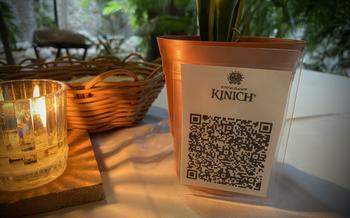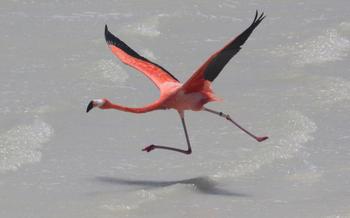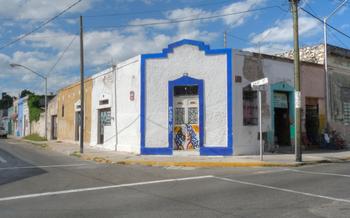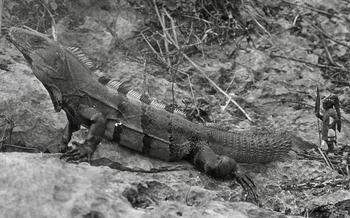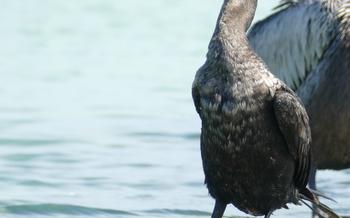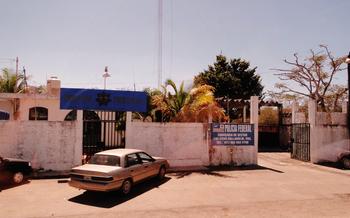
Ría Lagartos Biosphere Reserve
- Lovers
- Unique ecosystem
- Rich biodiversity
- Stunning landscapes
- Conservation efforts
- Getting to the Ría Lagartos Biosphere Reserve
- What to Do in the Ría Lagartos Biosphere Reserve
- Boat Tours in the Ría Lagartos Biosphere Reserve
- Wildlife Watching in the Ría Lagartos Biosphere Reserve
- Birdwatching in the Ría Lagartos Biosphere Reserve
- Visiting the Salt Flats of the Ría Lagartos Biosphere Reserve
- Exploring the Mangroves of the Ría Lagartos Biosphere Reserve
- Visiting the Town of Ría Lagartos
- What to Pack for a Trip to the Ría Lagartos Biosphere Reserve
- Tips for Visiting the Ría Lagartos Biosphere Reserve
- Insider Tip: Visit the Ría Lagartos Biosphere Reserve During the Pink Flamingo Season
Lovers
The Ría Lagartos Biosphere Reserve is a unique ecosystem that is home to a rich biodiversity of flora and fauna. The reserve's stunning landscapes and diverse wildlife make it a popular destination for nature lovers and outdoor enthusiasts. The reserve is also a UNESCO World Heritage Site, and it is recognized for its importance in conservation efforts.
Unique ecosystem
The Ría Lagartos Biosphere Reserve is a unique and diverse ecosystem that includes a variety of habitats, such as mangroves, salt flats, coastal dunes, and lagoons. This diversity of habitats supports a wide range of plant and animal species, making the reserve a biodiversity hotspot.
Rich biodiversity
The Ría Lagartos Biosphere Reserve is home to a rich variety of plant and animal species, including over 400 species of birds, 50 species of reptiles, and 20 species of mammals. The reserve is also home to a variety of fish and invertebrate species, including the critically endangered Yucatan toad.
Stunning landscapes
The Ría Lagartos Biosphere Reserve is a beautiful and diverse landscape that offers stunning views of the mangroves, salt flats, coastal dunes, and lagoons. The reserve is also home to a variety of wildlife, including flamingos, crocodiles, and monkeys, which can be seen in their natural habitat.
Conservation efforts
The Ría Lagartos Biosphere Reserve is a protected area that is managed by the Mexican government. The reserve is home to a number of endangered and threatened species, and it is a priority for conservation efforts. The Mexican government is working to protect the reserve and its wildlife through a variety of measures, such as habitat restoration, wildlife monitoring, and education programs.
Getting to the Ría Lagartos Biosphere Reserve
Location The Ría Lagartos Biosphere Reserve is situated on the northern coast of the Yucatán Peninsula, in the state of Yucatán, Mexico. It encompasses an area of over 600 square kilometers, including mangrove forests, coastal lagoons, salt flats, and pristine beaches.
Transportation Options Reaching the Ría Lagartos Biosphere Reserve is relatively easy. The closest major city is Mérida, the capital of Yucatán. From Mérida, you can either rent a car and drive the approximately two-hour journey or hop on a comfortable bus that will take you directly to the town of Ría Lagartos, the gateway to the biosphere reserve.
Guided Tours vs. DIY If you prefer a hassle-free experience, opting for a guided tour is a great choice. Many tour operators in Mérida offer day trips or multi-day excursions to the Ría Lagartos Biosphere Reserve, which typically include transportation, a boat tour, and a guided walk through the reserve. However, if you're an adventurous traveler who enjoys exploring at your own pace, you can rent a car and drive yourself to the reserve. This option gives you the flexibility to customize your itinerary and spend as much time as you like in each location.
hot and humid throughout the year, with average temperatures ranging from 25°C to 35°C. However, the best time to visit the reserve is during the dry season, which runs from November to May. During this time, the weather is sunny and dry, with little to no rain. This makes it ideal for exploring the reserve's mangroves, salt flats, and wildlife.
If you are interested in wildlife spotting, the best time to visit the Ría Lagartos Biosphere Reserve is during the winter months, when migratory birds from North America flock to the reserve. This is also the time when the flamingos are most likely to be seen. However, it is important to note that the reserve is open year-round, and there is always something to see and do, regardless of the season.
To avoid the crowds, it is best to visit the reserve during the week or outside of the peak tourist season, which runs from December to April. This will allow you to enjoy a more peaceful and intimate experience.
What to Do in the Ría Lagartos Biosphere Reserve
The Ría Lagartos Biosphere Reserve offers a plethora of activities for visitors to enjoy. Here are some of the most popular things to do:
Boat tours: Take a boat tour to explore the reserve's extensive network of canals and lagoons. These tours offer a chance to see the reserve's diverse wildlife, including crocodiles, birds, and fish.
Wildlife watching: The Ría Lagartos Biosphere Reserve is home to a variety of wildlife, including crocodiles, birds, and fish. Visitors can spot these animals from the shore, on boat tours, or on guided walks.
Birdwatching: The reserve is a haven for birdwatchers, with over 300 species of birds recorded. Some of the most popular birds to spot include flamingos, herons, egrets, and pelicans.
Kayaking: Kayaking is a great way to explore the reserve's tranquil waters. Visitors can rent kayaks from local operators and paddle through the canals and lagoons, getting up close to the wildlife.
Boat Tours in the Ría Lagartos Biosphere Reserve
At the heart of the Ría Lagartos Biosphere Reserve's experience lies the tranquility of boat tours, offering a unique perspective on the reserve's diverse ecosystems. Glide through the meandering channels, past lush mangroves, and into the open waters of the lagoon, where a symphony of wildlife awaits.
Types of Tours
Embark on a variety of boat tours tailored to different interests. Choose from shared or private tours, each offering a distinct experience. Shared tours provide an opportunity to mingle with fellow nature enthusiasts, while private tours allow for a more intimate encounter with the reserve's wonders.
Prices
Boat tour prices vary depending on the type of tour, duration, and group size. Expect to pay around $20-$50 for a shared tour and $100-$200 for a private tour. Prices may fluctuate based on the season and availability.
Duration
Boat tours typically last for around 2-3 hours, providing ample time to explore the reserve's diverse habitats. The duration may vary depending on the specific tour and the pace at which you wish to explore.
What to Expect
During your boat tour, expect to encounter an array of wildlife, including American crocodiles, turtles, and a variety of bird species. Keep an eye out for the elusive pink flamingos, known for their graceful presence in the reserve. The experienced boat guides will provide insightful commentary, ensuring you don't miss any of the reserve's hidden treasures.
Wildlife Watching in the Ría Lagartos Biosphere Reserve
The Ría Lagartos Biosphere Reserve is a haven for wildlife enthusiasts, with a diverse array of species to spot. Some of the most iconic creatures that call this reserve home include the American crocodile, the Yucatan black howler monkey, and the pink flamingo.
For the best wildlife-watching experience, it's recommended to embark on a guided boat tour. Knowledgeable guides will help you spot and identify the various species, and they can also provide information about their behavior and conservation status.
Some of the best places for wildlife watching in the reserve include the Ría Lagartos lagoon, the salt flats, and the mangrove forests. The lagoon is home to a variety of aquatic birds, including herons, egrets, and pelicans. The salt flats are a popular feeding ground for flamingos, while the mangrove forests provide shelter and nesting sites for a variety of birds and mammals.
To capture stunning wildlife photographs, it's important to bring a good camera with a telephoto lens. Patience and perseverance are also key, as animals can be elusive and may not always be easy to spot.
Birdwatching in the Ría Lagartos Biosphere Reserve
The Ría Lagartos Biosphere Reserve is a haven for birdwatchers, with over 300 species recorded within its borders. The diversity of habitats, from mangroves to salt flats, provides a variety of ecosystems for birds to thrive in. Some of the most commonly spotted species include herons, egrets, ibises, spoonbills, and flamingos.
Species to Spot
The reserve is home to a wide variety of bird species, including both resident and migratory species. Some of the most common birds to spot include:
- Flamingos: The reserve is home to a large population of flamingos, which can be seen wading in the shallow waters of the lagoon.
- Herons: There are several species of herons found in the reserve, including the great blue heron, the great egret, and the snowy egret.
- Egrets: Egrets are another common sight in the reserve, and can be seen perched on branches or wading in the shallows.
- Ibises: Ibises are a type of wading bird with long, curved beaks. The white ibis is the most common species found in the reserve.
- Spoonbills: Spoonbills are a type of wading bird with a long, spoon-shaped beak. The roseate spoonbill is the most common species found in the reserve.
Best Places for Birdwatching
The best places to go birdwatching in the Ría Lagartos Biosphere Reserve are:
- The lagoon: The lagoon is a great place to spot flamingos, herons, egrets, and ibises.
- The mangrove forests: The mangrove forests are home to a variety of bird species, including woodpeckers, flycatchers, and tanagers.
- The salt flats: The salt flats are a good place to spot shorebirds, such as sandpipers and plovers.
Tips for Birdwatching
Here are a few tips for birdwatching in the Ría Lagartos Biosphere Reserve:
- Bring binoculars: Binoculars will help you to get a closer look at the birds.
- Be patient: Birdwatching requires patience. It may take some time before you see the birds you are looking for.
- Be quiet: Birds are easily spooked, so it is important to be quiet when birdwatching.
- Respect the environment: The Ría Lagartos Biosphere Reserve is a fragile ecosystem. It is important to respect the environment and to leave no trace of your visit.
Visiting the Salt Flats of the Ría Lagartos Biosphere Reserve
The Ría Lagartos Biosphere Reserve is home to a number of salt flats, which are a fascinating and unique part of the landscape. The salt flats were created by the evaporation of seawater, and they are now covered in a thick layer of salt.
The salt flats are a popular destination for tourists, who come to see the stunning scenery and learn about the process of salt production. There are a number of guided tours available, which will take you to the salt flats and explain the history and process of salt production.
The salt flats are also a great place to see wildlife. The salt flats are home to a variety of birds, including flamingos, pelicans, and herons. You can also see a variety of reptiles, including crocodiles and turtles.
If you are visiting the Ría Lagartos Biosphere Reserve, be sure to add the salt flats to your itinerary. They are a truly unique and fascinating sight.
Exploring the Mangroves of the Ría Lagartos Biosphere Reserve
The Ría Lagartos Biosphere Reserve is home to extensive mangrove forests, which play a crucial role in maintaining the ecosystem's health and biodiversity. These unique ecosystems thrive in the salty waters of the lagoon, forming a labyrinth of tangled roots and verdant canopies.
Importance of Mangroves
Mangroves are highly adapted to their saline environment, possessing specialized root systems that allow them to filter and absorb nutrients from the water. They act as natural barriers, protecting the coastline from erosion and storm surges. Their intricate root structure provides a haven for marine life, creating nursery grounds for fish, crustaceans, and mollusks.
Mangrove Ecosystems
The mangroves of the Ría Lagartos Biosphere Reserve form a complex ecosystem, supporting a diverse array of plant and animal species. The intricate network of roots provides a habitat for crabs, oysters, and snails, while the canopies offer shelter for birds, insects, and reptiles. These interconnected ecosystems contribute to the overall health and stability of the lagoon.
Guided Tours
Exploring the mangroves is a mesmerizing experience, offering a glimpse into the unique biodiversity of the Ría Lagartos Biosphere Reserve. Visitors can embark on guided boat tours that navigate through the labyrinthine waterways, providing an up-close encounter with these remarkable ecosystems. These tours often include stops at observation decks, where visitors can learn about the mangroves' ecological significance and spot wildlife.
Visiting the Town of Ría Lagartos
Nestled at the heart of the biosphere reserve, the charming town of Ría Lagartos is a treasure trove of history and culture, beckoning travelers with its rich heritage and vibrant local life. Founded by Mayan fishermen in the 16th century, Ría Lagartos has retained its authentic charm, boasting colorful colonial buildings, narrow cobblestone streets, and a relaxed atmosphere that invites exploration.
Take a leisurely stroll through the town's central plaza, where you'll encounter the iconic Church of Our Lady of Guadalupe, a majestic testament to the town's religious devotion. Admire the intricate architecture, marvel at the ornate altarpieces, and soak in the tranquil ambiance that envelops the sacred space.
Immerse yourself in the town's vibrant culture by visiting the Ría Lagartos Museum, a treasure trove of historical artifacts and exhibits that chronicle the town's fascinating past and its enduring connection to the sea. Learn about the ancient Mayan civilization that once thrived in the region, the arrival of Spanish conquistadors, and the town's pivotal role in the salt trade that shaped its economy for centuries.
Indulge in the town's culinary delights by sampling the freshly caught seafood, a staple of the local cuisine. Savor the flavors of ceviche, a tangy concoction of raw fish marinated in citrus juices, or tantalize your taste buds with pan-fried fish, a crispy delight served with a variety of sauces. Don't miss the opportunity to try the local specialty, "Tikin Xic," a traditional Mayan dish featuring fish wrapped in banana leaves and cooked over an open fire, infusing it with a unique smoky aroma and flavor.
What to Pack for a Trip to the Ría Lagartos Biosphere Reserve
Essential Items - Sunscreen: The sun in Mexico can be intense, especially during the summer months. Bring a high-SPF sunscreen to protect your skin from harmful UV rays. - Insect repellent: The Ría Lagartos Biosphere Reserve is home to a variety of insects, including mosquitoes. Pack a DEET-based insect repellent to keep them at bay. - First-aid kit: A basic first-aid kit is always a good idea, especially if you plan on doing any hiking or kayaking. - Water bottle: Stay hydrated by bringing a reusable water bottle and filling it up throughout the day.
Clothing and Footwear - Lightweight, breathable clothing: The weather in the Ría Lagartos Biosphere Reserve is warm and humid, so pack light, breathable clothing. - Long-sleeved shirts and pants: To protect yourself from insects and the sun, pack long-sleeved shirts and pants. - Sturdy hiking shoes or sandals: If you plan on doing any hiking, bring a pair of sturdy hiking shoes or sandals. - Swimsuit: If you're planning on swimming or kayaking, bring a swimsuit.
Camera and Binoculars - Camera: The Ría Lagartos Biosphere Reserve is a photographer's paradise, so bring a camera to capture all the stunning scenery and wildlife. - Binoculars: Binoculars are essential for birdwatching and wildlife spotting. Bring a pair that is lightweight and easy to carry.
Tips for Visiting the Ría Lagartos Biosphere Reserve
To make the most of your trip to the Ría Lagartos Biosphere Reserve, there are a few tips to keep in mind. First and foremost, respect the environment. This is a fragile ecosystem, so it's important to avoid littering, disturbing the wildlife, and staying on designated trails.
Support the local community by hiring a local guide. They will be able to help you find the best spots for wildlife viewing and share their knowledge about the ecosystem. And finally, bring a camera and binoculars to capture the stunning scenery and wildlife.
Insider Tip: Visit the Ría Lagartos Biosphere Reserve During the Pink Flamingo Season
Timing
The pink flamingo season in the Ría Lagartos Biosphere Reserve typically runs from November to April. During this time, thousands of flamingos migrate to the reserve to feed and breed.
Where to See the Flamingos
The best place to see the flamingos is in the Ría Lagartos estuary. There are several boat tours that will take you to the flamingo colonies. You can also kayak or paddleboard through the mangroves to get a closer look at these majestic birds.
Tips for Photography
If you want to capture stunning photos of the flamingos, be sure to bring a camera with a long lens. You'll also need to be patient and wait for the flamingos to come close to your boat.
